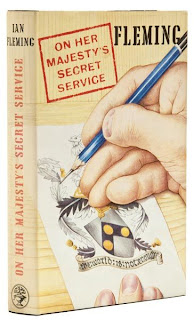130
Queen Victoria Street
London
Website:
www.college-of-arms.gov.uk
“The
College of Arms is in Queen Victoria Street on the fringe of the City. It is a
pleasant little Queen Anne backwater in ancient red brick with white sashed
windows and a convenient cobbled courtyard, where Bond parked his car.”
On Her Majesty’s
Secret Service,
Ian Fleming (Jonathan Cape, 1963)
 |
| View of the College from Queen Victoria Street |
The
College of Arms is a royal corporation which is the official repository of the
coats of arms and pedigrees of English, Welsh, Northern Irish and Commonwealth
families and their descendants. The officers of the College specialise in
genealogical and heraldic work which they undertake for their clients.
 |
| The first edition of On Her Majesty's Secret Service |
The
College and its work features prominently in Ian Fleming’s eleventh James Bond
novel On Her Majesty’s Secret Service both
as a setting and plot device. Having been despatched to the College by M, Bond
is initially unaware of the reason for his visit and is quizzed by one of the
College officers – who rejoices under the archaic title of Griffon Or – about
his own family background. This amusing interchange provides Fleming with the
pretext to provide us with some details of Bond’s roots. For instance we learn
that he has “no connexion with Peckham” and that his “father was a Scot” who
“came from the Highlands, near Glencoe” and that his “mother was Swiss”.
Griffon Or believes that Bond will be anxious to establish whether he is
related to Sir Thomas Bond, who gave his name to Bond Street in London’s West
End and whose family motto is Orbis non
sufficit or “the World is not enough”. The Bond coat of arms and motto provided the basis for Richard Chopping's cover design for the book's first edition.
After
this initial misunderstanding Bond learns from another of the College’s
officers, Sable Basilisk, that his arch enemy Blofeld has designs on the title
of “le Comte de Bleuville” and has asked the College to validate his claim.
This provides Bond with the opportunity to pose as “Sir Hilary Bray” - an envoy
of the College – and thereby gain access to Blofeld’s mountain-top lair Piz
Gloria.
The
College, which has stood in its present location since 1555, looks very much as
it did in Fleming’s day with the most recent addition being the gates which
were erected in 1956 - although modern visitors will be unlikely to regard the
present day Queen Victoria Street as a “backwater”!
Rating
(out of 10): 4











